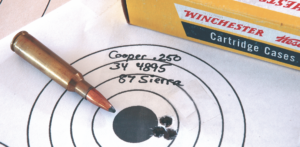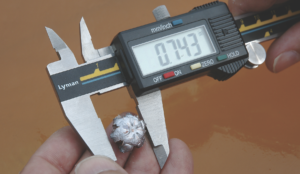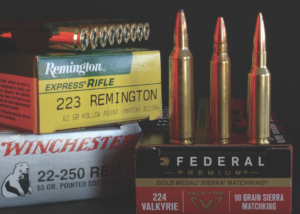Fast missiles fly flat and resist wind deflection except when they slow down. With the best predator bullets you want speed, power and accuracy at distance. (Photo: Wayne van Zwoll)
Starting velocity of a 48-grain softpoint in a .220 Swift factory load had been forever 4,110 fps. I memorized that stunning figure before entering the high school typing class that would inspire me to vow I’d never again rest my fingers on asdf jkl;.
I didn’t own a Swift then. Later I came by a Model 70. Its passing in an ill-advised trade at a gun show would inspire me to vow I’d never again part with a Swift.
For decades after its 1935 introduction in Winchester’s Model 54 bolt rifle, this cartridge topped speed charts. It strafed ‘chuck pastures and crow roosts in the East. It brought foxes to bag on the winter- scapes of Midwest farms and out-ran coyotes on the plains. The bullet was so quick, gravity worked hard to catch up. At 300 yards that little softnose dropped less than a .300 Savage missile at 200! Hoo boy!
But such comparisons have less relevance now. When the Swift was a yearling, Outdoor Life sold on newsstands for 15 cents. You could buy a Winchester 92 in .44-40 for $24.95. Pendleton peddled wool shirts for $5. And 300 strides was a long shot indeed.

Wayne’s load in a Cooper rifle excels! But the 87-grain bullet has a modest C, loses steam far away. (Photo: Wayne van Zwoll)
Distance, Speed and Drag
For those of us who actually hold rifles when we press the trigger, 300 is still long. But shooters these days commonly use bags, bipods or improvised rests. The accuracy of rifles and ammunition now, and the bright, sharp images of modern optics, draw shooters to ever-more-distant targets. Stunts on steel plates at ranges exceeding two miles follow exploits of snipers on foreign sand.
In 2009, Cpl.Craig Harrison of the British Army spied two Taliban fighters more than 2,700 yards away, which was 1,000 yards beyond the supersonic range of his .338 Lapua bullet. But the air was still and visibility excellent. Nine shots and his spotter’s help put Harrison onto an inert target. Exiting at 3,071 fps, the bullets fell 397 feet from the 109-yard zero –168 minutes of angle! Harrison turned his rifle on the enemy.
Neither of the Taliban heard the first shot. The report arrived nearly eight seconds after the bullet struck, probably after Harrison fired a second. He hit both men. A third shot disabled their machine gun.
While at this writing (in 2018) those kills remain the furthest in combat with the Lapua, a Canadian soldier used the .50 BMG to set a distance record in 2017, downing a hostile at 3,871 yards.
Rifles popular for deer and predators won’t match that performance. But with bullets designed for long shooting, you’ll extend their effective reach. The first thing to keep in mind: these aren’t fast bullets. A 285-grain Match bullet leaves the .338 Lapua case at 2,750 fps.
What? Don’t fast loads shoot flatter and hit harder at distance?
Think of a bullet not as a rocket but as shrapnel. Carried forward by momentum alone, it fights air all the way to the target. Air isn’t a void, like water, it imposes drag. Swimming, you feel it; a belly-flop from the board adds emphasis. Short, lightweight bullets at Mach 4 succumb readily to the drag you feel when you poke your arm out a car window at highway speed. At 500 yards, a Swift bullet sprinting out of the muzzle at 4,100 fps has slowed to 1,800. The .338 Lapua bullet that jogged from the rifle at 2,750 still clocks 2,200! A marathon pace.

Many bullets upset best at impact velocities from 1,600 to 3,000 fps. How fast are yours at 600 yards? (Photo: Wayne van Zwoll)
Ballistic coefficient
You’re loath to launch 285-grain hollowpoints at foxes? Me too. But the forces affecting snipers’ bullets apply as well to .224, .243, .257 and .264 spitzers.
Beginning in the mid-1700s, ballisticians in Europe tried to describe bullet flight mathematically. Accurate drag measurement eluded them until the late 1800s, when chronographs appeared in Germany and England. The notion of a “standard bullet” to assign benchmark values for drag had gained traction. The flight properties for any bullet might then be derived from its physical relationship with the standard bullet. “Ballistic coefficient” resulted. Commonly written as “C,” this number tells how a bullet combats drag. For those who revel in formulas: C= drag deceleration of the standard bullet/drag deceleration of an actual bullet of the same shape and density.
After our Civil War, studies by France’s Gavre Commission and by Krupp in Germany advanced the standard-bullet idea. Following publication of Krupp data in 1881, a Russian colonel named Mayevski developed a mathematical model showing drag deceleration of a flat-base conical bullet 3 calibers long, with 2-caliber ogive. U.S. Army Colonel James Ingalls followed with his Ingalls Tables in 1893. Revised in 1917, they describe a standard Krupp bullet similar to pointed hunting bullets now.
C is best determined by firing tests that yield flight time between points along a bullet’s path. But “Cs in loading manuals often miss the mark,” says Hornady’s Dave Emary. “Some are simply optimistic, others determined with few data points at short yardage, or at speeds under 2,500 fps.” Hornady currently verifies C with a Doppler unit spotting many points on the track of high-speed bullets to great range. You can also tap this formula: C=w/id2, where w is bullet weight in pounds, d is bullet diameter in inches and i is a form factor (profile). As drag increases with speed, velocity readings affect C.
You’ll see “G1” and “G7” with C in some data. G is for Gavre; 1 and 7 denote standard bullets. G1 shape mirrors a 19th-century artillery round; G7 better matches that of modern bullets with long noses and tapered heels. Because C is a comparative measure, it depends on which standard bullet (C = 1.000) you use. For example, the sleek 143-grain .264 ELD-X bullet produced by Hornady’s trials with Doppler radar has a G1 C of .620, but a G7 C of .311. It’s a distinction to keep in mind when reading about “long range” bullets.

Heavy bullets in Federal’s new 224 Valkyrie (right) outpace quick .223 and .22-250 loads downrange. (Photo: Wayne van Zwoll)
Drop and drift
The higher its C, the flatter a bullet flies, the better it battles wind and the more speed and energy it retains at distance. A soup can is ill adapted for flight (low i). But slim, short, pointed bullets also have low Cs, courtesy modest sectional densities (ratio of a bullet’s weight to the square of its diameter. A 55-grain .224 spitzer has almost exactly the same C as a round-nose 117-grain .257 bullet!
C affects bullet drop less than it affects drag — which by increasing flight time contributes to drop). Sierra tables show a Match bullet with a C of .600 and driven at 3,000 fps drops 58 inches at 500 yards. A bullet with a C of .400 drops 65 inches. That’s a small disparity, given the distance and 33 percent drop in C. Remaining punch: 2,256 ft-lbs (C=.600) and 1,929 ft-lbs (C=.400).
Deceleration rate strongly influences wind drift. Comparing bullets of the same diameter – here two pointed .30-bore bullets – shows the effect of C on downrange velocity, per the .220 Swift and .338 Lapua. While speed affects drift, C matters more. At 500 yards, the steeply decelerating 110-grain bullet has already given up its 700-fps edge and is about to lag the 180. Its drift is already greater. As distance increases, those gaps widen in favor of the 180.
A heavy bullet doesn’t necessarily perform better in wind, even if it’s of similar shape and C and driven about the same speed as a lighter one. A .223 bullet half the weight of the 110-grain .30-06 shows almost identical vulnerability to wind. Its slender profile is an asset.
Boat-tail bullets offer little advantage at normal hunting ranges, but have an edge far away, which is why target shooters insist on them at 600 and 1,000 yards. Example: Two 140-grain 7mm bullets, flat-base and boat-tail, started at 2,700 fps, both reach 100 yards moving at 2,500 fps. The boat-tail edges the flat-base at 200 yards, by 15 fps. At 350 steps it’s leading by 35 fps, for a difference in drop of about half an inch. Disparities in drift are similar. A 30-mph wind that nudges the flat-base bullet 17 inches at 350 yards moves the boat-tail bullet 15 ½ inches.
Best Predator Bullets
Most game bullets are designed to open at impact speeds down to 1,600 fps. Most pointed bullets started at 2,500 fps or faster keep that much hustle to 500 yards. By 600, the field shrinks. At 800, even 105-grain 6mm and 140-grain .264 Match bullets from frisky cartridges struggle to clock 1,600.
Bullet-makers are working to broaden velocity windows. Swift’s Scirocco expands down to 1,440 fps, says CEO Bill Hober. Federal engineer Jared Kutney claims TLR Edge bullets from a .30-06 upset in animals to 900 yards! These bullets are bonded, to penetrate with little weight loss at high impact speeds.
Bullets that fail to expand can cripple game that would die quickly from a high-speed hit. Stoked to 3,800 fps in a .22-250, Hornady’s 50-grain Spire Point has slowed to 1,400 fps at 600 yards, well shy of the opening threshold for most softpoints. And with just 220 ft-lbs remaining, that bullet can ill afford sub-par upset. Heavy HP Match bullets that hold velocity a tad better are no panacea. While many expand in animals, Hornady ballisticians say they’re not so designed and are unreliable killers.
There’s no substitute for speed. Fast bullets kill humanely. To deliver speed to distant predators, you’re smart to choose bullets with high ballistic coefficients and a marathon pace, the same bullets that most effectively battle drag and gravity and wind.






